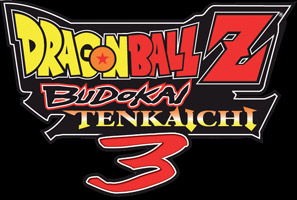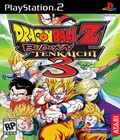Genre: Fighting
Developer: Spike
Publisher: Atari
Release Date: November 13, 2007 (PS2), December 3, 2007 (Wii)
It’s coming.
It’s coming, and honestly, I can hardly wait.
Dragon Ball Z: Budokai Tenkaichi is a franchise a great many people have followed intensely since its inception two sort years ago, and with good reason. Until this series came along, Dragon Ball Z fighting games were always missing a certain… something. Either the console wasn’t powerful enough to handle the large-scale fights seen in the DBZ manga/anime, or the developer was just looking for a quick cash-in (this was especially true in the ‘90s when fighting games were all the rage).
Either way, when Tenkaichi hit and brought nigh-every DBZ fanboy’s fantasies to life, no one saw it coming. The ability to fly freely through the sky, land punch-combos and teleports that spanned entire landscapes, and easily let loose super attacks and specialty techniques with apocalyptic results was too much of a rush not to be ignored. Having a solid fighting system reminiscent of Sega’s Virtual On series, honestly, was just icing on the cake.
Since then, Spike’s proven that they care about the quality of their product. Tenkaichi 2 saw so many changes, addition, updates and tweaks to their original idea – and which actually worked to boot -- that for a short while, said sequel was winning awards all over the place. Critics had to admit that the game was just really good, despite it being about Dragon Ball Z, of all things.
So, we finally come to Tenkaichi 3. This sequel isn’t as large-scale as the previous installment because, frankly, everything but the kitchen sink was tossed into Tenkaichi 2. Still, Spike did manage to pull a few more rabbits out of their hat.
First off, the fighting engine’s been tweaked once again. It doesn’t look it to someone who hasn’t been obsessively following the game, but there have been a few changes to bring about further balance. Damage between characters has been lessened slightly from canon power levels. Krillin will still have a tough time against, say, Android 18, but this time he may be able to stick around for, oh, maybe 20 seconds rather than eight. It helps to make the game fun, and to provide an incentive to try new characters rather than just sticking to the power guys for easy wins.
Air combos after launchers are a bit more “canned” than before – this time they have speed lines and a bit more animation behind them when buttons are mashed. Counters and sneak attacks are easier to perform than ever, with the ability to Dragon Dash behind your opponent, and have back-and-forth teleport faceoffs. This opens up the potential for mind games. Rush supers are nerfed once again, with range being shortened, and many of them losing their innate homing abilities and priority over standard punches. They’re still powerful, but are no longer sure, cheap hits. You have to pick your windows to use them, such as in knocking an enemy for a loop beforehand. Finally, there’s also far less super move recycling than in either of the previous two games. Barring a couple of shared energy wave barrages, everyone finally really does feel unique now in this regard.
The versus mode now has the option to play with ratio-based fighters, similar to the original Capcom vs. SNK, or even DBZ: Supersonic Warriors 2. You’re given a certain amount of “Destruction Points” to work with, and you can choose fighters who have point values assigned to them. Low-level characters such as Videl are two points or so, but try to pick a monster like Super Saiyan 4 Gogeta, and that’s a whopping 9 points down the drain. It really does add a sense of fairness to matches, though you can still have ratio-free fights as well.
If you thought Tenkaichi 2’s cast was huge, Tenkachi 3 makes one redefine that term. There are over 160 fighters in here (yes, counting transformations, but each transformation provides an entirely new moveset and fighting attributes), each one worth giving a spin at least once. Tenkaichi 3 pulls fighters from Dragon Ball Z, GT, and the original Dragon Ball. From headliners like Pan and Janemba to obscurities such as Devilman and Fasha, odds are you’ll be pleasantly surprised at someone’s arrival. There’s even a Dr. Slump character in here if you look hard enough.
Since there wasn’t a whole lot to add to the competitive side of things compared to last year, this year Spike added a whole bunch of contributions to the single-player side of things. As opposed to previous years, when all you basically had was a barely-creative story and Survival Mode, there’s a whole smattering of ways to spend your time in Tenkaichi 3 while you’re waiting for friends to challenge you.
The biggest change is to the story mode itself. It’s been completely redone. Instead of trying to jam in every single fight ever made in Dragon Ball history, Tenkaichi 3 only goes for its “greatest hits,” so to speak. This means that the story mode has significant fewer entries, but each one is worth multiple battles in itself. Imagine fending off Piccolo, Vegeta and the Earth Forces as Frieza, or experiencing the helplessness of your fight against Raditz as Piccolo and Goku. The addition of quick-time sequences, dynamic fight banter, scripted events that plunge you into even more action, and optional story progression (you can choose to press a button and keep the original plot going, or finish a fight your own way) add to the coolness factor.
As for the objective to each battle? You’ve got to find out for yourself. Maybe you need to win, maybe it’s just to survive. Heck, maybe you have to lose. Prior knowledge of the series’ plots will help to guide you. It’s like directing your very own episode, and some of these (such as the “What If” battle that pits all of the Saiyan forces against all of Frieza’s forces) can get really epic really fast.
When you’re done with Story Mode, you can take part in Dragon World Tour, which is a collecton of World Tournaments with special special rules and twists. There’s also yet another Mission Mode, and Sim Dragon, an RPG-esque survival mode where you take up the train-fight-train routine of your average DBZ fighter.
Both versions of the game will ship with their own unique aspects. The Playstation 2 version comes packed with a “Disc Fusion” feature. Plug in a copy of Tenkaichi 1 or Tenkaichi 2 at the right menu screen, and you’ll be able to unlock the Ultimate Battle modes from both of those games. It’ll great to play the old 100-fighter Ultimate Battle from the original Tenkaichi now that the fighting system’s refined enough to make it truly fun (as opposed to an exercise in rush-super frustration).
The Wii version, meanwhile, sports slightly updated graphics and Wiimote/Nunchuk motion controls, which are still as hit-or-miss as they were last time. On the one hand, the entire control scheme makes 300% more sense than before. There’s no crazy cursor on the screen, and the motions required to unleash special attacks are far easier to do this time. Command lists are no longer a nightmare of text. Of course, that’s when you try to do a Dragon Dash Combo, and realize that it just doesn’t work. Oh, well, maybe next year. Thankully, the game is easily playable with both the Gamecube and Classic Controller (my favorite for the Wii version)., and there are separate tutorials provided for each.
Even better, the Wii version of BT3 is the only one with online play. Finally, the ardurous task of finding competition in this game amongst a sea of people who like to pretend they’re too “cool” for DBZ (usually while hiding the fact that they were knee-deep into it themselves half a decade ago) has been rendered moot. When you’re done practicing on your own, jump into the online arena, or recruit like-minded folks with Friend Codes, and prepare to take on all challengers. (A note: once this game hits, if you see someone using Great Saiyaman #2 a little too often, it’s probably me. Be afraid.)
Tenkaichi 3 is set to hit stores in just a few weeks, and not only will it make your old versions of the game obsolete, but it’s set to once again provide one of the year’s most fulfilling fighting experiences. With controls that are slightly easier to get into yet still yield impressive results, and the ability to almost perfectly recapture the spirit of authentic Dragon Ball Z fight sequences, this is one fighting game not to be taken lightly just because of its anime license.
Because let’s face it: you just haven’t lived until you’ve punched a guy through a mountain.
More articles about Dragon Ball Z: Budokai Tenkaichi 3











 In Dragon Ball Z: Budokai Tenkaichi 3, all DBZ skills and abilities are intact including: free flight, range and melee attacks. With over 150 DBZ heroes and villains and more than 30 battle stages, players are given the power to engage in titanic battles with the ability to recreate some of the storied confrontations from the TV show, or they can create all-new showdowns of their own with characters that never actually fought in the animated series. The game also features exciting new game modes like the Battle Replay mode that lets players save and replay favorite battles.
In Dragon Ball Z: Budokai Tenkaichi 3, all DBZ skills and abilities are intact including: free flight, range and melee attacks. With over 150 DBZ heroes and villains and more than 30 battle stages, players are given the power to engage in titanic battles with the ability to recreate some of the storied confrontations from the TV show, or they can create all-new showdowns of their own with characters that never actually fought in the animated series. The game also features exciting new game modes like the Battle Replay mode that lets players save and replay favorite battles.


































